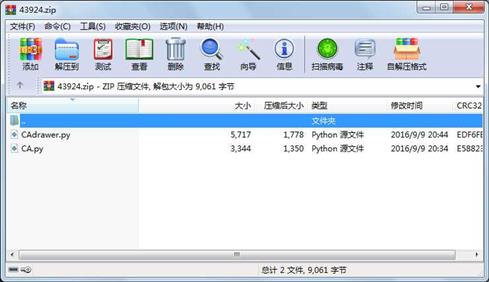资源简介
定义元胞自动机CA的代码和相应的绘图程序

代码片段和文件信息
“““ Code example from Complexity and Computation a book about
exploring complexity science with Python. Available free from
http://greenteapress.com/complexity
Copyright 2011 Allen B. Downey.
Distributed under the GNU General Public License at gnu.org/licenses/gpl.html.
“““
import numpy
class CA(object):
“““A CA is a cellular automaton; the parameters for __init__ are:
rule: an integer in the range 0-255 that represents the CA rule
using Wolfram‘s encoding.
n: the number of rows (timesteps) in the result.
ratio: the ratio of columns to rows.
“““
def __init__(self rule n=100 ratio=2):
“““Attributes:
table: rule dictionary that maps from triple to next state.
n m: are the number of rows columns.
array: the numpy array that contains the data.
next: the index of the next empty row.
“““
self.table = self.make_table(rule)
self.n = n
self.m = ratio*n + 1
self.array = numpy.zeros((n self.m) dtype=numpy.int8)
self.next = 0
def make_table(self rule):
“““Returns a table for the given CA rule. The table is a
dictionary that maps 3-tuples to binary values.
“““
table = {}
for i bit in enumerate(binary(rule 8)):
t = binary(7-i 3)
table[t] = bit
return table
def start_single(self):
“““Starts with one cell in the middle of the top row.“““
self.array[0 self.m/2] = 1
self.next += 1
def start_random(self):
“““Start with random values in the top row.“““
self.array[0] = numpy.random.random([1self.m]).round()
self.next += 1
def loop(self steps=1):
“““Executes the given number of time steps.“““
[self.step() for i in xrange(steps)]
def step(self):
“““Executes one time step by computing the next row of the array.“““
i = self.next
self.next += 1
a = self.array
t = self.table
for j in xrange(1self.m-1):
a[ij] = t[tuple(a[i-1 j-1:j+2])]
def get_array(self start=0 end=None):
“““Gets a slice of columns from the CA with slice indices
(start end). Avoid copying if possible.
“““
if start==0 and end==None:
return self.array
else:
return self.array[: start:end]
def binary(n digits):
“““Returns a tuple of (digits) integers representing the
integer (n) in binary. For example binary(33) returns (0 1 1)“““
t = []
for i in range(digits):
n r = divmod(n 2)
t.append(r)
return tuple(reversed(t))
def print_table(table):
“““Prints the rule table in LaTeX format.“““
t = table.items()
t.sort(reverse=True)
print ‘\\beforefig‘
print ‘\\centerline{‘
print ‘\\begin{tabular}{|c|c|c|c 属性 大小 日期 时间 名称
----------- --------- ---------- ----- ----
文件 3344 2016-09-09 20:34 CA.py
文件 5717 2016-09-09 20:44 CAdrawer.py
- 上一篇:漏洞扫描器源代码
- 下一篇:Python实现循环神经网络RNN
 川公网安备 51152502000135号
川公网安备 51152502000135号
评论
共有 条评论